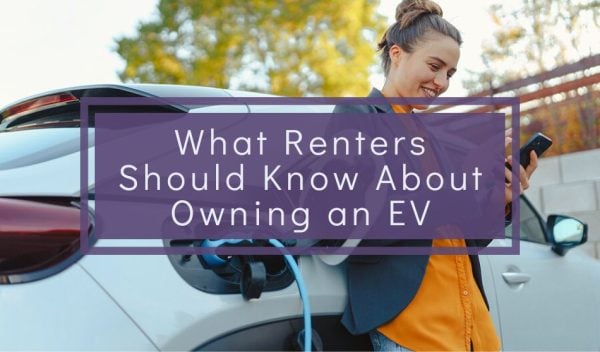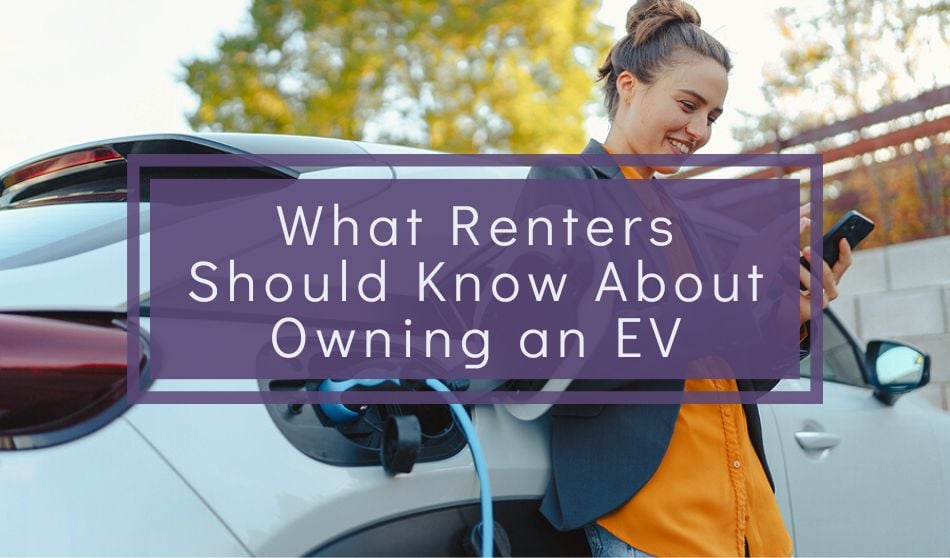
There’s no doubt that electric vehicles (EVs) are becoming more and more popular. Some are making the switch hoping to find an eco-friendly commute or save on fuel costs. Owning and caring for an electric vehicle is certainly easier if you own a home. However, renting does not necessarily mean you cannot have an electric vehicle. Here are some considerations for renters who want to own an EV.
EV Charging Information:
Owning an electric vehicle requires regular access to a charging station or home charger. Charging is separated into different levels based on the current draw and speed at which the charger can power the vehicle. Each level has different requirements and gives a certain amount of miles per charge.
Before considering an EV, renters need to understand what charging options already exist in their home and area. Some landlords may be willing to modify the property to accommodate charging on-site. To determine whether an electric vehicle is practical for you as a renter, you will need to fully understand the benefits and drawbacks of each charging level.
- Level 1 charging: This is the most basic level of charging that the owner of an EV can use. Level 1 charging simply utilizes an extension cord run from a standard outlet. For any EV owner, this charging method is likely impractical unless you drive very short distances or can leave the car plugged in overnight.
- Level 2 charging: Level 2 charging gets the owner of the EV more mileage per charge and requires 240V of electricity. This charging option may require installing a specific charging outlet if one is not already present. If you live in a bigger city, look for an apartment complex that offers level 3 or 2 chargers to residents as an amenity.
- Level 3 charging (Also Known as “Fast Chargers”): The most powerful level of charging, level 3 chargers are typically over 800V and rapidly charge electric vehicles. These are cost prohibitive and are harder to install.
Special Considerations About Level 1 EV Charging for Renters:
Since Level 1 charging cables plug into a common 120V outlet, it is the most readily available option for renters. Level 1 charging can come with its share of downsides and even potential safety concerns. Level 1 charging takes a long time to power a vehicle for daily driving. Level 1 cables pull a lot of current and have built-in safety protection that prevents them from drawing enough to overheat. Unfortunately, an extension cord between the device and the outlet can render it ineffective. Experts disagree on when it is safe to use an extension cord, so the best practice is to avoid it when possible and check specific manufacturer recommendations. Your landlord will likely have safety concerns if an extension cord is blocking a walking path or hanging out of your 2nd story apartment window to reach your car.
Secondarily to safety, for renters and landlords, the most important detail about charging on a standard outlet is who pays for the extra electricity used. In a residential community, you may find there are lease addendums that state explicitly who is responsible for electric car charging since some multifamily homes will even split the electric usage.
How to Talk to Your Landlord About an Adding an EV Charger:
Not all landlords will be interested in offering a charging option for electric vehicles, and not all properties have sufficient electrical panels and services to accommodate electric vehicles (this is particularly true for buildings with older infrastructure). This means that upgrading can be costly for a landlord.
That said, there are some instances when it will make sense for your landlord to add charging capabilities to their rental property, and it never hurts to ask or show your interest so your landlord can make that determination as more renters seem to be interested.
Learn more: How to Accommodate Electric Vehicles at Your Rental Property
What to Say to Your Landlord to Get Them to Add an EV Charger at Apartment Complexes:
While a charger may seem like an excellent and forward-thinking feature, the best apartment amenities have a wide range of appeal to those already living in the residential community. Getting your landlord or property manager interested in upgrading your parking area to accommodate charging for an electric car or truck can be easier if you do your research before broaching the conversation.
- Talk to other residents in the community to gauge interest.
- If interest is high, your landlord will be far more likely to look into electrical charging options.
- Provide ample information.
- Landlords or property managers who are unfamiliar with electric vehicles will need general information on how to accommodate electric vehicles at their rental property
- Tell your landlord to look for incentives or tax credits that may be available in your area for installing EV charging stations at multifamily properties.
- Be flexible.
- Remind your landlord that community chargers can be paid for by those using electric vehicles, which offers renters the opportunity to charge easily on-site and helps landlords make a return on their investment.
- If your apartment or townhouse has a garage, ask to help pay for the installation of a home charger that a single-family homeowner would use.
What to Say to Your Landlord to Get Them to Add an EV Charger at a Single-Family Rental Home:
Renters who live in a single-family rental home often have more ability to cater the home to their personal needs or preference, especially if you have lived at the property long-term. Having a great relationship with your landlord can go a long way to get your requests met in cases like these.
- Be a good renter.
- A good renter is hard to find; being a responsible and kind tenant will make your landlord want to keep you happy. If a home EV charger can ensure tenant retention, many landlords or property managers will consider allowing the upgrade.
- Offer to pay–or help pay–for the upgrade.
- Since residential EV chargers are the least expensive to install, offer to pay for the charger and all (or part) of the installation to make it easy for your landlord to say yes. Some chargers require little installation and simply need to be plugged into a 240v outlet which may already exist in your home’s garage.
- Be willing to accommodate a small rent increase.
- Upgrades require an initial investment from the property owner, which can eventually lead to rent increases for the tenant. While a residential charger can be relatively inexpensive in many homes, some properties will need to update their electricity panel to accommodate the charger which could drive up the costs.
- Look into incentives in your area.
- Many incentives will be directed toward homeowners and multi-family property owners. Still, you may find programs that can help offset installation costs in your area if you are willing to do a little additional research.
When Can Owning an EV be Difficult as a Renter?
An electric vehicle requires access to a charger; it’s a reality that not all rental homes will be set up with a good space to allow your vehicle to charge efficiently. Moreover, not all landlords will be open to making upgrades. After all, the demand is still emergent and is not yet a deal breaker for most tenants. With today’s hot rental market, many landlords will not see the benefit of investing in emerging infrastructure at their rental properties.
While forward-thinking residential properties may be happy to take the leap–some hoping to stand out from the competition in anticipation of a cooler rental market–many landlords and property managers will be unwilling to offer the feature until it is in high demand. For renters who cannot charge at home due to a lack of charging options, or know they may not have access after their lease term at their current rental, it may be impractical to transition to an electric vehicle in the immediate future.
What Are Other Electric Vehicle Charging Options for Renters?
Renters who cannot charge at home do have options. Many municipal areas feature level 2 and Level 3 chargers in downtown or other key areas within the city. Some cities even offer free charging incentives to encourage local commerce, and some larger workplaces offer electric charging to employees.
Ready access to paid and free charging stations where you already commute is key if you are a renter hoping to own an electric vehicle. This can make it exceedingly convenient for commuters who have vehicles with a large enough range to easily charge during work hours, while grocery shopping, or while visiting their favorite local restaurant.
The potential downsides of this solution do exist, but good planning can prevent them from being a significant hindrance for an eager electric vehicle owner. Charging at public stations may be cost-inefficient for electric vehicle owners who are relying primarily on paid fast chargers.
Renters need to plan to access alternative charging sites within an accessible range from their home. Renters should expect their regular charging site to eventually be down for maintenance or occupied by other vehicle owners. If you cannot charge at home, and your location and vehicle range means you can only rely on one charging station, you could find yourself in a sticky situation down the road.
When Should a Renter Avoid Getting an EV?
Renters who cannot charge at home may need to seriously consider whether now is the best time to transition to an EV. Not having access to a home charger can mean EV ownership ranges from impractical to impossible, depending on your circumstances.
Plug-in hybrid or hybrid vehicles may be a practical option for renters looking to reduce fuel costs or make their commute more eco-friendly. Renters who live in a walkable rental area should also consider walking, biking, or using an electric bike for their short commute. Public transportation is also an efficient and cost-effective alternative for those with physical disabilities, small children, or who aren’t interested in a physically demanding commute.





